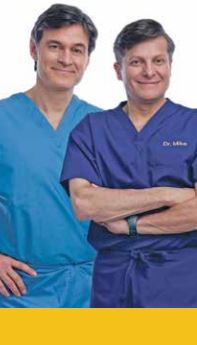
If you type the word “exercise” into the Google search window, you get about 1.72 billion results! The available info covers everything from A to Z: “Arthritis and Exercise” (a good thing for sure) and (we quote) “Fatigue, exercise, intolerance and weakness: lessons on herding Zebras.” No wonder it’s hard to figure out just what exercises to do.
Well, recent studies reveal that you don’t need to worry so much about whose exercise mantra you adopt or whether you take the stairs at work, swim, walk to the store, bicycle, jog or take a yoga class.
If you’re one of the 77 percent of Canadians who don’t get even the minimal recommended amount of general physical activity or structured and planned exercise (at least 150 to 300 minutes weekly of moderate-intensity, or 75 to 150 minutes weekly of vigorous-intensity aerobic physical activity, or an equivalent combination), have we got news for you.
The largest study ever of cardiovascular fitness in healthy folks (more than 300,000 of them!) was presented recently at EuroPrevent 2019. It found that moving more — however you do it — is linked to living longer, regardless of age, sex or starting fitness level. Even the least fit participants in the study who began to move more saw benefits in longevity. It was related to each milliliter increase in their maximal oxygen uptake (VO2 max).
So there’s futzing around in the house and lawn, walking, climbing stairs, tending to daily tasks and turning off the TV and getting out of that chair and then there’s a purposeful workout routine at home, the gym or outside. You need them both.
What it boils down to is Move, Breathe, Live.
• Try to limit sitting to 30 to 60 minutes at a stretch, then do jumps, climb stairs or walk for at least five minutes. Set a reminder on your phone to get you up regularly.
• In addition, try to be active for at least two hours a day. That might be walking in the mall, taking the stairs at work, mowing the lawn, cooking dinner, etc. Use the stopwatch on your smartphone to keep track of how much moving around you do.
• Get at least 30 minutes of planned aerobic exercise a day, too.
That’s one key. The other key to fitness and longevity turns out to be muscle POWER, not muscle strength.
Researchers from Brazil presenting at the same European Society of Cardiology conference explained that power depends on the ability to generate force and velocity, and to coordinate movement. Climbing stairs requires power: The faster you climb, the more power you need. According to study author professor Claudio Gil Araujo: “Rising from a chair in old age and kicking a ball depend more on muscle power than muscle strength, yet most weight-bearing exercise focuses on strength. Our study shows for the first time that people with more muscle power tend to live longer.”
So how do you achieve more power in your muscles? The researchers say at any age you should do multiple exercises for upper and lower body muscles and muscle groups. Try this two or three times a week for 20-30 minutes:
• Choose a weight (using hand weights, stretchy bands or weight machines) that’s a bit of a challenge but not so heavy you can barely lift it.
• Do one to three sets of six to eight repetitions moving the weight as fast as possible while you contract your muscles and use a slower, natural speed as you return to your initial position. If you cannot do the repetitions or sets comfortably, dial it back with less weight and fewer reps! No injuries, please. Build power over time.
• Rest for 20 seconds between each set to sufficiently replenish the energy stores in your muscles.
There’s the simple one-two-three formula for a longer, healthier life and a younger RealAge: Move It + Move It More + Move It Quickly = Longevity.
To live your healthiest, tune into “The Dr. Oz Show” or visit www.sharecare.com. (c)2019 Michael Roizen, M.D. and Mehmet Oz, M.D. Distributed by King Features Syndicate, Inc.
-Mehmet Oz, M.D. and Mike Roizen, M.D.
